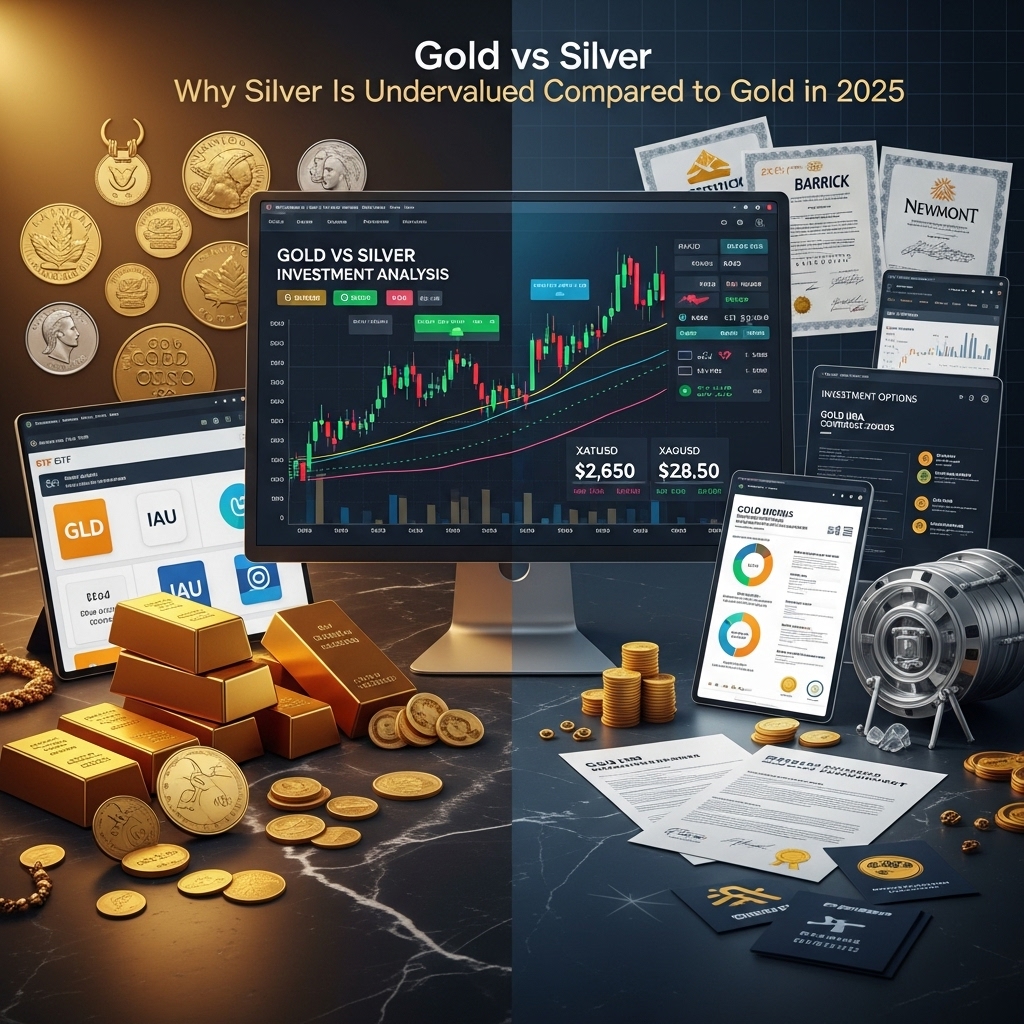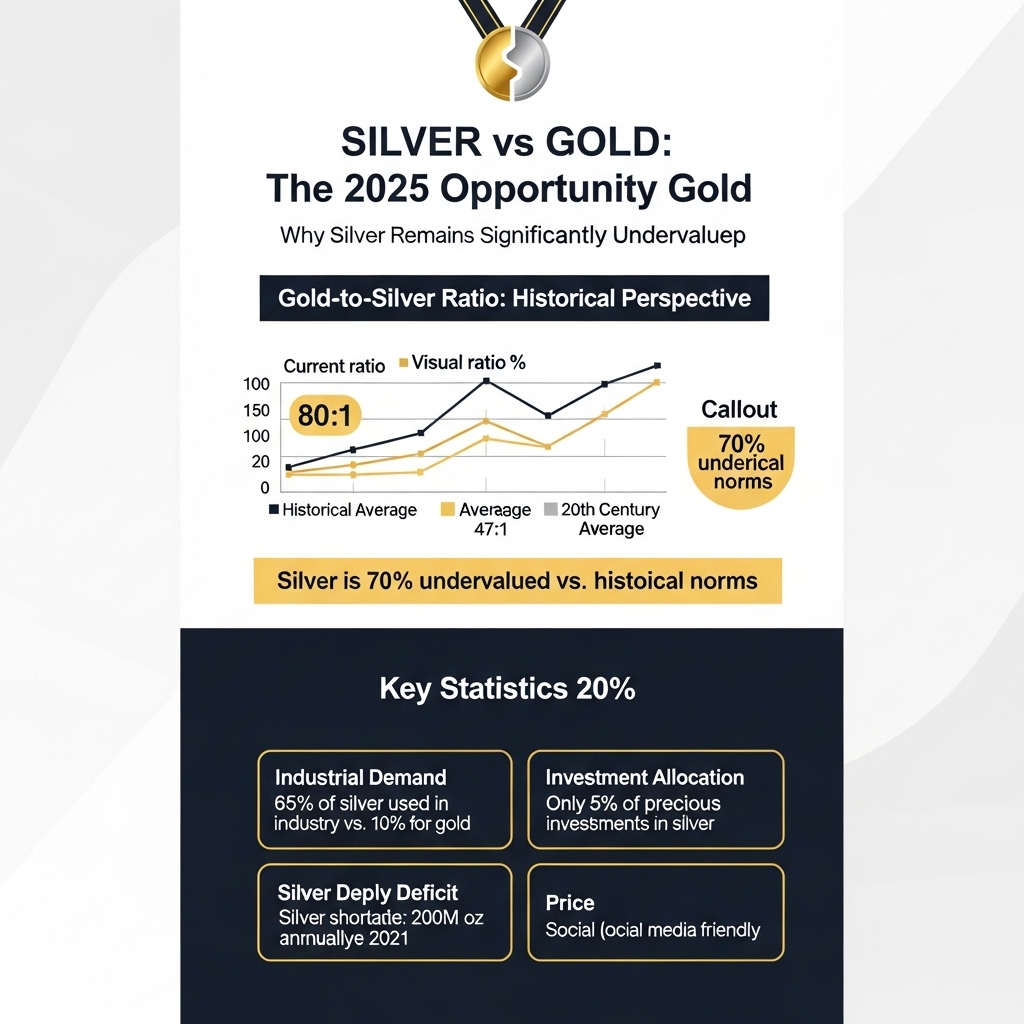Why Savvy Gold Investors Are Taking a Second Look at Silver in 2025
While gold continues its impressive run—reaching new highs above $2,400 per ounce in 2024—a growing number of seasoned precious metals investors are quietly shifting their attention to gold’s often-overlooked cousin: silver. The current gold-to-silver ratio has stretched to levels not seen since the early 2000s, creating what many analysts believe is one of the most compelling arbitrage opportunities in the precious metals market today.
This dramatic pricing disparity isn’t just a statistical curiosity—it represents a potential wealth-building opportunity that gold investors can’t afford to ignore. Throughout this analysis, we’ll examine the historical relationship between these two precious metals, explore the industrial demand drivers that are reshaping silver’s fundamental value proposition, and uncover why the current market conditions may have created a perfect storm for silver’s outperformance.
For gold investors, understanding silver’s undervaluation isn’t about abandoning your core precious metals strategy—it’s about optimizing it. Whether you’re looking to diversify your existing gold holdings, capitalize on mean reversion opportunities, or hedge against potential shifts in precious metals leadership, the case for silver in 2025 deserves serious consideration. The data suggests we may be witnessing a rare moment where the market has mispriced one of history’s most reliable stores of value.
Gold Market Analysis and Key Insights
Current Gold Market Performance and Valuation Metrics
Gold has reached unprecedented heights in 2024, with prices surpassing $2,400 per ounce amid global economic uncertainty and central bank accumulation. The gold-to-silver ratio currently sits at approximately 75:1, significantly above the historical average of 50:1, suggesting potential overvaluation relative to silver. Despite strong performance, gold’s momentum appears to be moderating as investors seek alternative precious metals opportunities.
Central Bank Policies and Institutional Demand
Central banks continued their aggressive gold purchasing throughout 2024, acquiring over 1,000 tonnes for the second consecutive year. However, this institutional demand has created artificial price elevation, with retail investors now facing premium entry points. The Federal Reserve’s monetary policy shifts and anticipated rate cuts in 2025 may reduce gold’s appeal as a yield-alternative investment, potentially redirecting capital flows toward silver.
Investment Portfolio Diversification Benefits
Gold remains the cornerstone of precious metals portfolios, offering proven wealth preservation during inflationary periods. Current market conditions favor a 60-40 gold-to-silver allocation rather than traditional 80-20 splits. This rebalancing strategy allows investors to maintain gold’s stability benefits while capitalizing on silver’s undervaluation and industrial demand growth.
Expert Recommendations for 2025
Leading precious metals analysts suggest maintaining core gold positions while strategically increasing silver exposure. Goldman Sachs projects gold prices stabilizing between $2,300-$2,500 throughout 2025, indicating limited upside potential compared to silver’s projected 25-35% growth trajectory. Investment advisors recommend dollar-cost averaging into silver positions while holding existing gold allocations as portfolio anchors.
The convergence of gold’s matured bull market cycle, silver’s industrial demand surge, and the historically wide price ratio creates compelling reasons for precious metals investors to reassess their allocation strategies. While gold maintains its safe-haven status, silver’s dual investment-industrial nature positions it for superior returns in the current market environment.

Gold Investment Strategies and Options
Physical Gold Investments
Direct ownership through bullion coins, bars, and numismatic pieces offers tangible security but requires storage considerations and insurance costs. The American Gold Eagle and Canadian Maple Leaf remain premier choices for investors seeking liquidity and recognition.
Gold ETFs and Mining Stocks
Exchange-traded funds like GLD and IAU provide convenient exposure without physical storage requirements. Gold mining stocks offer leveraged exposure to gold prices but carry additional operational risks. Major miners like Newmont and Barrick Gold can amplify returns during bull markets while increasing volatility.
Risk Assessment and Portfolio Allocation
Conservative portfolios typically allocate 5-10% to precious metals, while aggressive investors may increase exposure to 15-20%. Gold’s negative correlation with stocks during market stress makes it an effective hedge, though this relationship isn’t guaranteed.
Investment Method Comparison
Physical gold offers complete ownership but lacks income generation. ETFs provide liquidity and lower transaction costs but involve counterparty risk. Mining stocks deliver potential dividends and growth but experience higher volatility than gold itself.
Market Timing Considerations
Dollar-cost averaging minimizes timing risk over extended periods. Key indicators include real interest rates, inflation expectations, and currency weakness. Gold typically performs well during economic uncertainty, currency debasement, and geopolitical tensions.
Strategic Implementation
Diversify across investment vehicles to balance security and performance. Consider rebalancing quarterly to maintain target allocations. Monitor macroeconomic indicators including Federal Reserve policy, inflation data, and global debt levels. Remember that gold serves as portfolio insurance rather than a primary growth vehicle, making patient, long-term positioning essential for optimal results.
Market Performance and Outlook
Silver has significantly underperformed relative to gold over the past decade, creating a compelling value proposition for 2025. The gold-to-silver ratio currently hovers around 80:1, substantially above its historical average of 60:1, indicating silver’s relative undervaluation. While gold reached new all-time highs in 2024, exceeding $2,400 per ounce, silver has struggled to maintain consistent momentum above $30 per ounce.
Current Market Dynamics
The precious metals market in 2025 faces several catalytic factors. Central bank gold purchases have driven institutional demand, while silver benefits from growing industrial applications in solar panels, electronics, and emerging technologies. Supply constraints affect both metals, but silver’s dual role as an industrial and monetary metal creates additional demand pressure.
Economic Headwinds for Gold
Rising real interest rates and potential Federal Reserve policy shifts pose challenges for gold’s premium valuation. As inflation concerns moderate and economic stability improves, gold’s safe-haven premium may compress, making silver’s industrial demand story more attractive.
Future Projections
Technical analysis suggests silver could outpace gold if the ratio normalizes toward 60:1. Conservative projections indicate potential 20-30% relative gains for silver, driven by industrial demand growth of 3-5% annually and constrained mine supply. The green energy transition alone could add 15-20% to silver’s industrial consumption by 2027, supporting sustained price appreciation beyond traditional monetary demand patterns.
Frequently Asked Questions About Gold Investment
Is silver really a better investment than gold in 2025?
Silver offers compelling advantages including a historically low gold-to-silver ratio of 80:1 compared to the natural ratio of 16:1. With increasing industrial demand from solar panels, electronics, and electric vehicles, silver combines precious metal stability with growth potential that gold typically lacks.
What drives silver’s industrial demand growth?
Silver’s unique properties make it irreplaceable in green technology. Solar panel production alone consumes 20% of annual silver supply, while electric vehicle manufacturing requires 3x more silver than traditional cars. This industrial consumption creates sustained demand beyond investment purposes.
How does silver’s volatility compare to gold?
Silver exhibits higher volatility, which creates both risks and opportunities. While gold moves 10-15% annually, silver can swing 25-40%. For investors seeking portfolio diversification and potential higher returns, silver’s volatility can work favorably during precious metals bull markets.
Should I replace my gold holdings with silver?
Consider a balanced approach rather than complete replacement. Many experts suggest a 70/30 or 60/40 silver-to-gold ratio in precious metals portfolios, allowing you to benefit from silver’s upside potential while maintaining gold’s stability.
What are the storage considerations for silver?
Silver requires more storage space due to lower value density. Factor in secure storage costs when calculating investment returns, though these expenses are often offset by silver’s appreciation potential.

Final Thoughts on Gold Investment
The evidence is clear: silver presents a compelling opportunity for gold investors seeking diversification and value in 2025. With the gold-to-silver ratio hovering near historic highs, silver’s industrial demand surge, and its dual role as both precious metal and technology commodity, the white metal offers exceptional upside potential.
Key takeaways for gold investors:
– Silver trades at a significant discount relative to gold
– Industrial applications drive additional demand beyond precious metal appeal
– Portfolio diversification benefits complement existing gold holdings
Our recommendation: Consider allocating 10-20% of your precious metals portfolio to silver while maintaining your core gold position. This balanced approach captures silver’s undervaluation while preserving gold’s stability.
Ready to optimize your precious metals strategy? Download our free 2025 Silver Investment Guide and speak with our certified precious metals advisors to create a personalized allocation plan that maximizes your portfolio’s potential.